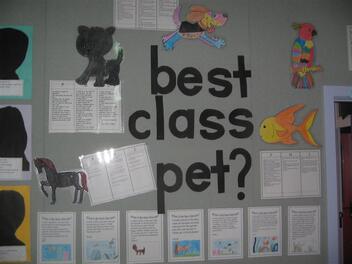
Opoutere School Classroom Pet Inquiry
Two classes undertook an inquiry into which was the best classroom pet for them to get. The classes were a year 0 - 2 (5 & 6 year olds) class with their teacher Donna Harper and a year 2 - 3 ( 6 & 7 year olds) with their teacher Zania Watt. Some teachers, when considering inquiry-based learning, say that it is fine for older students but not for juniors. This inquiry is proof juniors can do it.
Students first established the criteria for their pet, then researched each choice. Investigations included visits to a farm, the Katikati Bird Gardens and the local vet. Various pets visited the classroom and their owners were interviewed about their pet’s needs.
Students used PMIs (de Bono's Plus Minus Interesting) to sort the information they had gathered about their pets. They then wrote persuasive arguments to convince other classroom members that their choice was the best. Students then voted on the pet that best met their criteria. Goldfish won the day and were purchased for the classrooms.
There were three clear purposes for this inquiry. The first was the authentic purpose of choosing a classroom pet. This had arisen after a school Pet Day. The second was to introduce PMIs as a thinking strategy and the third it was to develop the use of written persuasive arguments. For the younger students this was a new genre. The older children had an additional purpose of developing their interview techniques.
Teachers in the classrooms found great benefits from using an inquiry approach. As one of the teachers commented, “Kids take you places you never realised when you build on student’s prior knowledge”. She also felt that the inquiry “gave space to students who think outside the square”.
For more detail scroll down below the slideshow.
Two classes undertook an inquiry into which was the best classroom pet for them to get. The classes were a year 0 - 2 (5 & 6 year olds) class with their teacher Donna Harper and a year 2 - 3 ( 6 & 7 year olds) with their teacher Zania Watt. Some teachers, when considering inquiry-based learning, say that it is fine for older students but not for juniors. This inquiry is proof juniors can do it.
Students first established the criteria for their pet, then researched each choice. Investigations included visits to a farm, the Katikati Bird Gardens and the local vet. Various pets visited the classroom and their owners were interviewed about their pet’s needs.
Students used PMIs (de Bono's Plus Minus Interesting) to sort the information they had gathered about their pets. They then wrote persuasive arguments to convince other classroom members that their choice was the best. Students then voted on the pet that best met their criteria. Goldfish won the day and were purchased for the classrooms.
There were three clear purposes for this inquiry. The first was the authentic purpose of choosing a classroom pet. This had arisen after a school Pet Day. The second was to introduce PMIs as a thinking strategy and the third it was to develop the use of written persuasive arguments. For the younger students this was a new genre. The older children had an additional purpose of developing their interview techniques.
Teachers in the classrooms found great benefits from using an inquiry approach. As one of the teachers commented, “Kids take you places you never realised when you build on student’s prior knowledge”. She also felt that the inquiry “gave space to students who think outside the square”.
For more detail scroll down below the slideshow.
Classroom Pet Inquiry Plan
- Brainstorm then discuss and develop criteria for a pet. Record and display for future reference.
- Brainstorm possible pets. Record for future reference. Add pets to this chart if they arise during the inquiry.
- Visit to Katikati Bird Gardens (or similar place).
- Two different birds brought to school and their owners are interviewed about pet needs and what it is like having a bird for a pet.
- Research the pet using various book and internet resources. For younger students or those with lower reading ability this could be done as a whole class shared reading lesson. Video eg and multi-media sites eg Dog Care are helpful.
- PMI (de Bono's Plus, Minus, Interesting chart) having a bird for a pet. This could be done as a whole class initially with young student then in groups. Display these.
- Repeat steps 3 - 6 with various pets e.g. a farm was visited to see a horse and a a pony was brought to school by its owner.
- Visit to vet - interview vet to find out needs of pets. Add information to the PMIs that arises from the interview. Revise criteria if necessary.
- Visit to S.P.C.A. - interview helper to find out needs of pets. Add information to the PMIs that arises from the interview. Revise criteria if necessary.
- Revisit PMIs. Narrow down to three - five choices using criteria.
- Students choose one of these pets.
- Students explain (verbally and in writing) the reasons for their choice in the form of a persuasive argument.
- Students vote on the class pet. Graph results to find chosen pet.
- Purchase the pet - this could be a mini inquiry as well.
2021

